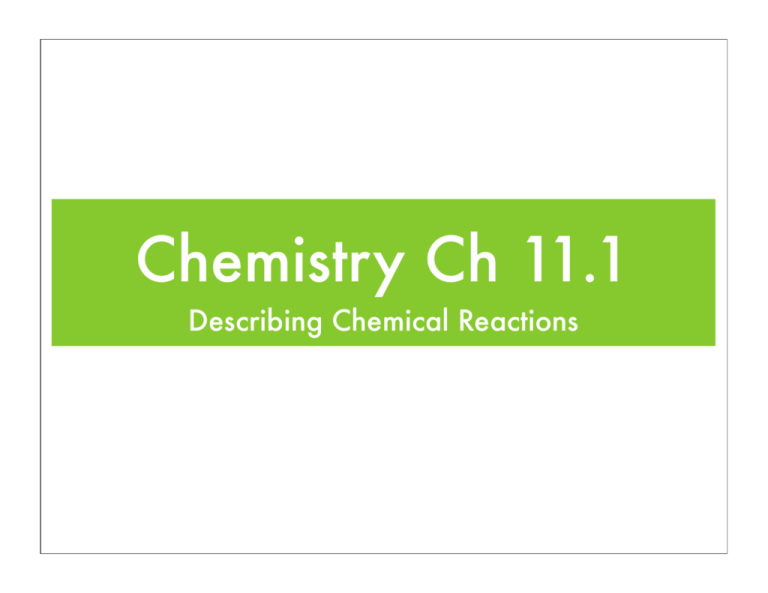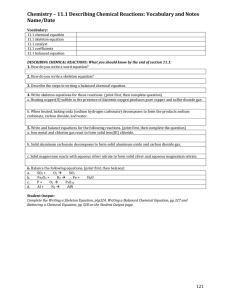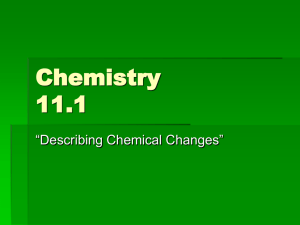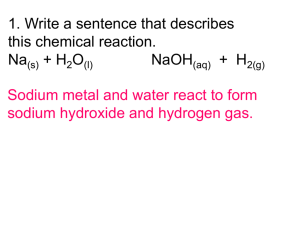Chemistry Ch 11.1
advertisement

Chemistry Ch 11.1 Describing Chemical Reactions • Big Idea: Reactions • Big Questions: • 1. How do chemical reactions obey the law of conservation of mass? • 2. How can you predict the products of a chemical reaction? Objectives: • Describe how to write a word equation. • Descri e how to write a skeleton equation. • Balance chemical reactions using the law of conservation of mass. • Describe the steps for writing a balanced chemical equation. Vocabulary: • chemical equation • skeleton equation • catalyst • coefficients • balanced equation • (Law of Conservation of Mass) Key to Presentation • Letters on “slides” are for questions to answer after reading and discussion of section 11.1 • Numbers on “slides” refer to problems on Section Assessment on pg 329 • Practice Problems should be answered on the output page in notebook. A. How do you write a word equation? B. How do you write a skeleton equation? C. What is a catalyst and how do you include it in an equation? Practice Problems: Writing a Skeleton Equation, pg 324 • 1. Write a sentence that describes this chemical reaction. • Na(s) + H2O(l) NaOH(aq) + H2(g) Practice Problems: Writing a Skeleton Equation, pg 324 • 2. Sulfur burns in oxygen to form sulfur dioxide. Write a skeleton equation for this chemical reaction. Include appropriate symbols from Table 11.1 10. Write skeleton equations for these reactions • a. Heating copper(II) sulfide in the presence of diatomic oxygen produces pure copper and sulfur dioxide gas. • Cu+ O2 Cu + SO2 • b. When heated, baking soda (sodium hydrogen carbonate) decomposes to form the products sodium carbonate, carbon dioxide, and water. • NaHCO3 Na2CO3 + CO2 + H2O D. Describe the steps in writing a balanced chemical equation. E. What are coefficients? F. What is a balanced equation? G. What is the law of conservation of mass? Practice Problems: Writing a Balanced Chemical Eqution • Balance each equation: • a. 2AgNO3 + H2S Ag2S + 2HNO3 • b. 3Zn(OH)2 + 2H3PO4 6H2O Zn3(PO4)2 + 11. Write and balance equations for the following reactions • a. Iron metal and chlorine gas react to form solid iron(III) chloride. • 2Fe(s) + 3Cl2(g) 2FeCl3(s) • b. Solid aluminum carbonate decomposes to form solid aluminum oxide and carbon dioxide gas. • Al2(CO3)3(s) Al2O3(s) + 3CO2(g) • c. Solid magnesium reacts with aqueous silver nitrate to form solid silver and aqueous magnesium nitrate. • Mg(s) + 2AgNO3(aq) 2Ag(s) + Mg(NO3)2(aq) 12. Balance the following equations. • a. SO2 + O2 SO3 12. Balance the following equations. • b. Fe2O3 + 3 H2 2 Fe + 3 H2O 12. Balance the following equations. • c. 4 P + 5 O2 P4O10 12. Balance the following equations. • d. 2 Al + N2 2 AlN






